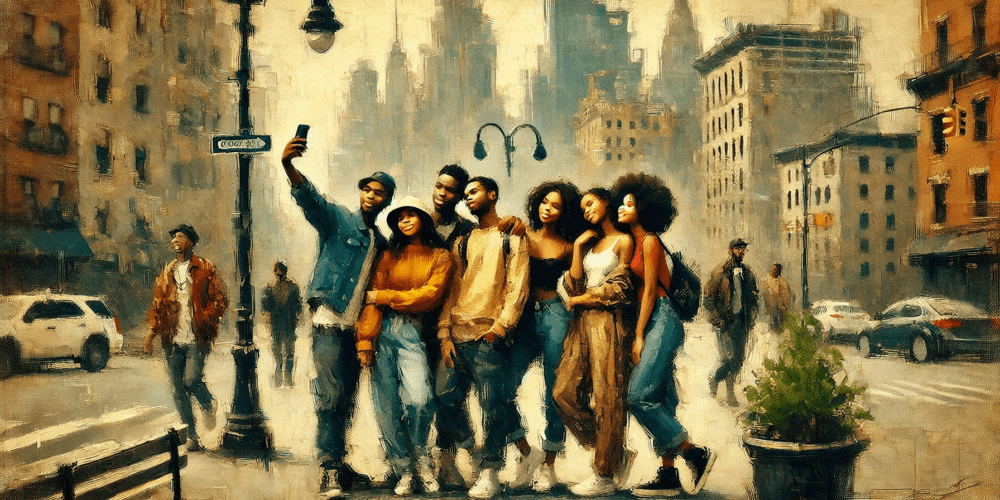To really sell? Focus on beliefs, not products

We find ourselves in photographs all the time these days. Even diehard introverts like me can’t escape the lens and are constantly dragged into photos by family, friends, and even colleagues and clients. Ever since the smartphone camera landed in billions of hands, photography exploded. It’s as if every moment now needs its stamp. I saw an estimate that claims that by 2026 we humans will be taking, wait for it, two trillion photos every year.
The interesting thing to observe, however, is how we look in all these photos. Now that photography is a daily occurrence, we all seem to be posers! There is a way to stand, jut, tilt and grin that seems to be known by everyone (except me). But have you ever looked at the photos of yesteryear—those taken of your grandparents and great-grandparents? Most of the time, they were standing straight and rigid—and pretty much never smiling.
What was that about?
Marcus Collins knows the answer, and shares it in his excellent new book, For the Culture. He tells us that in photos taken before the twentieth century, there is pretty much a 100 per cent chance that no one in the picture will be smiling at all. Why? The reveal will surprise you. It has less to do with the technology of cameras and the advancement of dentistry. It’s more about the power of culture.
Here’s Marcus’s rib-cracking reveal: “In those days, practitioners of the fine arts considered smiling to be a practice saved for peasants, dimwits, drunks, or children.” I’ll wait for you to stop laughing and gather yourself, so that we can go deeper!
Smiling in a photo back then meant you were a lower-class person. So basically, no-one would smile in photos, even those of the lower classes, to protect their desired social status. That meant photographs were only taken for formal occasions and for archival documentation, not while merrymaking.
Enter Eastman Kodak. The clever folks there started advertising using photographs of smiling, happy people. The company changed the norms of society, not because of product advancements, but more powerfully because it understood the power of culture. It ruled over the photography world for decades as a result (and then bizarrely went on to miss the cultural shift caused by first the digital camera, and then the smartphone).
In recent times, Apple has done something similar by creating a cult-like following. Those who buy Apple don’t buy products; they buy self-identification and a shared way of life. Marcus recounts a 2011 MRI study of the brains of Apple fans after they were presented with messaging from the brand. What did the researchers find? That the regions of the brain being stimulated were exactly those that lit up in religious people when they were exposed to the artefacts of their faith. In other words, the same feelings and excitement are conjured in the minds of dedicated Apple buyers, as those of the prayerful during worship.
Beyoncé also gets selling to a culture. Her fans call themselves “beys” in a devout community called the “Beyhive.” This culture has its language: news about Beyoncé is called “pollen,” and the hive will “swarm” online should anyone criticize or attack their queen. Marcus worked on digital strategy for brand Beyoncé, and shares his invaluable experience in selling to a belief system in his book.
Do you know who else gets it? Donald Trump. His stunning comeback victory this week reveals again the power of selling to a culture. The Make America Great Again (MAGA) movement is not a political coalition; it is a belief system and a shared identity. It is an angry, intolerant, anti-establishment grouping whose flames are constantly fanned by its chosen candidate. Its members self-identify, and as became clear again, can command great unity of purpose at the ballot box.
What do we learn about selling to cultures? The first thing that a brand must do is look inward and identify its core beliefs—if it has any. Marcus tells us that vain platitudes and empty statements won’t cut it. If you have an authentic belief system, you will attract those who share your beliefs about the world. When people buy into your beliefs, they buy into you—products come second. What you are looking for is your congregation, to whom you can preach your gospel.
When you can communicate your beliefs to the people who hold the same deeply felt ideological views, you can start to sell big. Marcus quotes these remarkably insightful words from C. C. Chapman: “Start with the soul and end with the sale.”
A closing thought, though. Let’s use this insight to do good, not to manipulate. Don’t make this about creating trending brands or manufacturing loyalty; make it about sustaining a bond rooted in authenticity. For any brand or leader to sustain cultural influence, the beliefs must be real—deeply held, not just convenient. The essence of long-lasting influence is conviction, and that only comes from brands with authentic beliefs.
Politicians are the ones with the most to answer for in this regard. Will Trump’s identity politics actually deliver anything worthwhile to his MAGA voters? We have four more years to find out.
(Sunday Nation, 10 November 2024)

Buy Sunny Bindra's new book
The X in CX
here »
Popular Posts
- The pause that saves usJune 8, 2025
- Where are you rushing to—your funeral?June 29, 2025
- How to spot a real thinkerJune 15, 2025
- Built the app, forgot the flowJune 22, 2025
- The first push is the hardestJune 1, 2025















